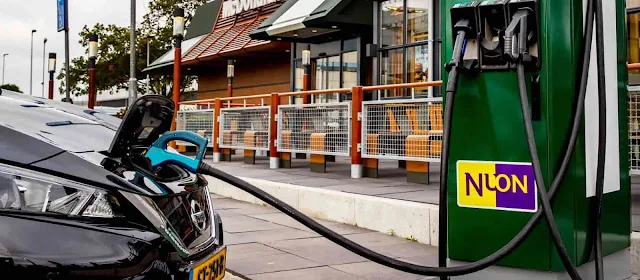CHARGING BASICS 104: Where to charge electric vehicles ? | Domestic, Semi-public & Public charging points
Many people think it is hard to find charging points for electric vehicles. But the number of plug-in stations has increased rapidly in recent years. More than 190,000 public charging positions are now available across Europe or in other terms just 7 cars per each charge point. (source: EU Transport & Environment Org)
Charging points for electric vehicles are usually categorized by their degree of accessibility for drivers. The main categories of charging points are generally defined as private, semi-public and public.
Private/domestic charging points
Private/domestic charging points are found
in homes and business premises. They include dedicated charging boxes or common
household plugs. Home charging is a simple option for electric vehicle owners,
since no subscription or membership fees are needed to access the charging
point. Private charging also occurs when companies install charging points for
use by employees on business premises.
Home charging naturally tends to be more common
in suburban or rural areas than in urban neighborhoods, as it requires the car
owner to have access to a private garage or be able to connect the electric
vehicle to a household socket. In cities, where vehicles are normally parked on
public streets or in semi‑public car parks,
it is more difficult to access a private charging point.
Semi-public charging points
These types of charging points are situated
on private ground, but can be accessed by external users. Examples include charging
points located in commercial car parks, shopping centres or leisure facilities.
Access to these charging points is typically restricted to clients or
customers.
Operators often regard the charging points
as a complimentary service or an opportunity to advertise, so they do not charge customers for
the power used. In other cases, the electricity used is included in the
customer's parking bill, or in the utilization fee for car‑sharing schemes. Most fast‑charging facilities are semi-public and, like conventional petrol
stations, are built on private ground but open to all paying users.
Public charging points
Public charging points are usually placed alongside
roadside parking spaces or in public car parks. While private or semi‑public charging points are often wall boxes, the public
infrastructure usually consists of standalone charging poles. In some cases, municipal
utilities provide these charging points.
However, local authorities are increasingly
commissioning commercial providers to facilitate the construction and operation
of public charging infrastructure.
In some cities, public charging points are free
for electric vehicle users. Tesla also offers a network of fast-charging points
across Europe for free use by owners of certain models. Such free charging
points are designed to provide an early incentive
for consumers to purchase electric vehicles. In the longer term, if electric
vehicles become more common, free charging for electric vehicles is likely to
disappear.
Elsewhere, a wide range of payment systems
are used at charging points. At public or semi-public charging points, different
payment and identification methods are possible. Users are often identified by
means of a smart card and are subsequently charged for the actual power used.
This can mean that each user needs to register and keep several smart cards from different operators in order to access enough charging points. In other cases, electricity suppliers register specific vehicles and provide each vehicle with a digital identification key. Registered vehicles are then recognized at charging points without the user needing a card. This system is known as 'plug and charge'.
Other technical options for user identification include phone hotlines, text messages, 'smart cables' that have an integrated SIM card, PIN numbers and even physical keys. Sometimes customers can pay directly at the charging point (with a bank card or cash), or in combination with a proof for paying car parking fees. Both identification and payment can increasingly be done using smartphone apps.
Several initiatives have tried to simplify the variety of payment options used in Europe. They aim to make an ever-greater number of charging points available for all electric vehicle users by forming consortia of charging infrastructure providers and facilitating 'eRoaming'. That does away with the need for owners to always hold several smart cards from different operators. At the EU level, the Alternative Fuels Infrastructure Directive (EU, 2014) made ad-hoc access to charging stations mandatory as well as requiring 'reasonable, easily and clearly comparable, transparent and non-discriminatory' prices.











Post a Comment